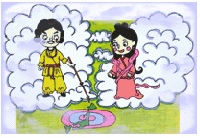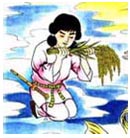History and Deities
History
It was thought that Japanese God descended in the top of the mountain or the specific tree called goshinboku, or the sacred forest. Once, the entire Iimori Mountain was the precincts.
In 859 (Jogan year), Emperor Seiwa sent an imperial messenger, Wake Kiyotomo, to order to build three shrines in Mt. Iimori, at the highest (Jougu), middle (chugu), and lowest ground (Gegu).
Also he ordered to hold 26 rituals festivals throughout the year. That's the foundation of Iimori Shinto Shrine.The shrine prospered grandly and solemnly in the middle age, however, because of the hourly wars, most of the buildings became the ashes.
In 1650 (the Edo period), when the time of the second feudal lord of Fukuoka, Tadayuki Kuroda, the present shrine building was rebuilt by his large oblation.
In 1672, a village headman of the neighboring village (Noke village), Souemon Nagasima, purchased 86,000 Tsubo (1Tsubo=3.3u) of the land of the Mt. Iimori and contributed to the shrine.
Deities
 The deity enshrined at the main building of Iimori shrine is a female kami, the goddess, Izanami who created the country. (The creation myth of Shinto, recorded in the 712 Kojiki)
The deity enshrined at the main building of Iimori shrine is a female kami, the goddess, Izanami who created the country. (The creation myth of Shinto, recorded in the 712 Kojiki)
In Japanese mythology, Izanami-no-Mikoto, also given as ÉQf¸ or É×ßü½, meaning "she who invites" is the goddess of both creation and death, as well as the former wife of the god Izanagi-no-Mikoto. They were the first male and female kami and they created not only the country, but also many kinds of kami. Since she was dead after giving a birth of the god of fire, she went to the land of death (Yomi or Yomi-no-kuni) and ruled over the land.
Iimori Shrine is located at the west side of Fukuoka. Across the Fukuoka plains, there is the Wakasugi mountain, where her husband god (Izanagi-no-Mikoto) living. He is enshrined at Taso shrine which located the east side of Fukuoka. The both mountains are called a couple mountains, and they are always watching and protecting us over the Fukuoka city now.
Iimori shrine is sometimes called the shrine of Musubi, means tying people together. If people want to get married, they would come to this shrine to pray for a good marriage. But it's not only for a marriage between people, also means to connect with the gods and people too.
On the left of the main building,
Tamayorihime-no-Mikoto is enshrined.
Tamayori-bime, also given as ÊËù½ or ÊËP¸ is a goddess in Japanese mythology.
Tamayori-bime is Watatsumi (the god of the sea)'s daughter and also Toyotama-hime (LÊP)'s younger sister. She brought up Ugayafukiaezu, a son of Hoori (ν) and Toyotama-bime.
And after, Tamayori-bime married Ugayafukiaezu and has had five children including the first Emperor of Japan, Jimmu. Tamayori means Yorishiro, an object to embody Gods. Tamayori-bime is a woman Yorishiro, Miko.
On the right of the main building,
Hondawake-no-Mikoto is enshrined.
Hondawake-no-Mikoto, also given as iÉaC½ or _cʸ is a god of the war and the divine protector of Japan and its people.Hondawake-no-Mikoto is also known as Emperor ?jin 201~310 (_Vc). He was the 15th emperor of Japan, according to the traditional order of succession.
It is said that he is the first Emperor who actually existed and identified as some of the earliest historical emperor. According to the Kojiki and the Nihonshoki, ?jin was the son of the Emperor Ch?ai and his consort Jing?.
On the middle of Iimori Mountain,
Itakeru-no-Mikoto is enshrined.
 Itakeru-no-Mikoto, also given as Ü\Ò¸ is a god in Japanese mythology, and he is a grandson of Izanami-no-Mikoto. Also Itakeru-no-Mikoto is a son of Susanoo-no-Mikoto (the god of the sea and storms).
Itakeru-no-Mikoto, also given as Ü\Ò¸ is a god in Japanese mythology, and he is a grandson of Izanami-no-Mikoto. Also Itakeru-no-Mikoto is a son of Susanoo-no-Mikoto (the god of the sea and storms).
Susanoo-no-mikoto ordered Itakeru-no-Mikoto to spread trees in order to make the whole land green. So he is also called Isanoshio-kami (L÷_) or Ohoyahiko-no-kami (å®äÃ_), and is worshiped for the forest protection.